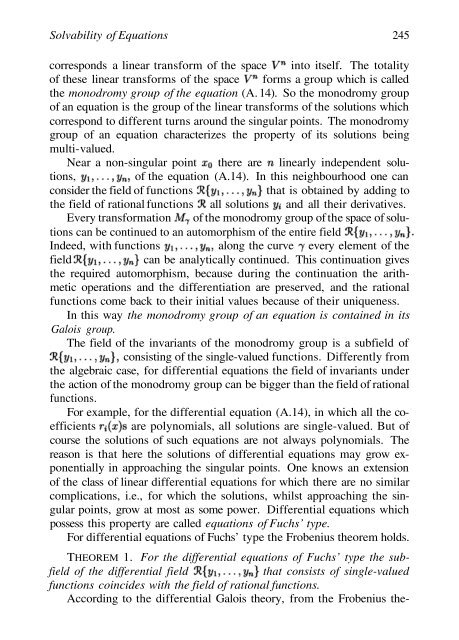Abel's theorem in problems and solutions - School of Mathematics
Abel's theorem in problems and solutions - School of Mathematics
Abel's theorem in problems and solutions - School of Mathematics
Create successful ePaper yourself
Turn your PDF publications into a flip-book with our unique Google optimized e-Paper software.
Solvability <strong>of</strong> Equations 245<br />
corresponds a l<strong>in</strong>ear transform <strong>of</strong> the space <strong>in</strong>to itself. The totality<br />
<strong>of</strong> these l<strong>in</strong>ear transforms <strong>of</strong> the space forms a group which is called<br />
the monodromy group <strong>of</strong> the equation (A. 14). So the monodromy group<br />
<strong>of</strong> an equation is the group <strong>of</strong> the l<strong>in</strong>ear transforms <strong>of</strong> the <strong>solutions</strong> which<br />
correspond to different turns around the s<strong>in</strong>gular po<strong>in</strong>ts. The monodromy<br />
group <strong>of</strong> an equation characterizes the property <strong>of</strong> its <strong>solutions</strong> be<strong>in</strong>g<br />
multi- valued.<br />
Near a non-s<strong>in</strong>gular po<strong>in</strong>t there are l<strong>in</strong>early <strong>in</strong>dependent <strong>solutions</strong>,<br />
<strong>of</strong> the equation (A.14). In this neighbourhood one can<br />
consider the field <strong>of</strong> functions that is obta<strong>in</strong>ed by add<strong>in</strong>g to<br />
the field <strong>of</strong> rational functions all <strong>solutions</strong> <strong>and</strong> all their derivatives.<br />
Every transformation <strong>of</strong> the monodromy group <strong>of</strong> the space <strong>of</strong> <strong>solutions</strong><br />
can be cont<strong>in</strong>ued to an automorphism <strong>of</strong> the entire field<br />
Indeed, with functions along the curve every element <strong>of</strong> the<br />
field can be analytically cont<strong>in</strong>ued. This cont<strong>in</strong>uation gives<br />
the required automorphism, because dur<strong>in</strong>g the cont<strong>in</strong>uation the arithmetic<br />
operations <strong>and</strong> the differentiation are preserved, <strong>and</strong> the rational<br />
functions come back to their <strong>in</strong>itial values because <strong>of</strong> their uniqueness.<br />
In this way the monodromy group <strong>of</strong> an equation is conta<strong>in</strong>ed <strong>in</strong> its<br />
Galois group.<br />
The field <strong>of</strong> the <strong>in</strong>variants <strong>of</strong> the monodromy group is a subfield <strong>of</strong><br />
consist<strong>in</strong>g <strong>of</strong> the s<strong>in</strong>gle-valued functions. Differently from<br />
the algebraic case, for differential equations the field <strong>of</strong> <strong>in</strong>variants under<br />
the action <strong>of</strong> the monodromy group can be bigger than the field <strong>of</strong> rational<br />
functions.<br />
For example, for the differential equation (A.14), <strong>in</strong> which all the coefficients<br />
are polynomials, all <strong>solutions</strong> are s<strong>in</strong>gle-valued. But <strong>of</strong><br />
course the <strong>solutions</strong> <strong>of</strong> such equations are not always polynomials. The<br />
reason is that here the <strong>solutions</strong> <strong>of</strong> differential equations may grow exponentially<br />
<strong>in</strong> approach<strong>in</strong>g the s<strong>in</strong>gular po<strong>in</strong>ts. One knows an extension<br />
<strong>of</strong> the class <strong>of</strong> l<strong>in</strong>ear differential equations for which there are no similar<br />
complications, i.e., for which the <strong>solutions</strong>, whilst approach<strong>in</strong>g the s<strong>in</strong>gular<br />
po<strong>in</strong>ts, grow at most as some power. Differential equations which<br />
possess this property are called equations <strong>of</strong> Fuchs’ type.<br />
For differential equations <strong>of</strong> Fuchs’ type the Frobenius <strong>theorem</strong> holds.<br />
THEOREM 1. For the differential equations <strong>of</strong> Fuchs’ type the subfield<br />
<strong>of</strong> the differential field that consists <strong>of</strong> s<strong>in</strong>gle-valued<br />
functions co<strong>in</strong>cides with the field <strong>of</strong> rational functions.<br />
Accord<strong>in</strong>g to the differential Galois theory, from the Frobenius the-

















